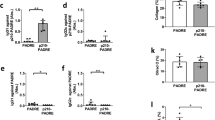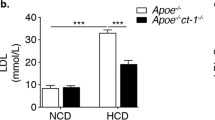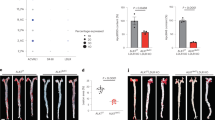Abstract
We tested the efficacy of low-density lipoprotein receptor (LDLR) therapy using helper-dependent adenovirus (HD-Ad), comparing it with that of very low-density lipoprotein receptor (VLDLR), an LDLR homolog. We treated high cholesterol diet fed LDLR−/− mice with a single intravenous injection of HD-Ad expressing monkey LDLR (1.5 × 1013 or 5 × 1012 VP/kg) or VLDLR. Throughout the 24-week experiment, plasma cholesterol of LDLR-treated mice was lower than that of VLDLR-treated mice, which was in turn lower than that of PBS-treated mice. Anti-LDLR antibodies developed in 2/10 mice treated with high-dose HD-Ad-LDLR but in none (0/14) of the other treatment groups. HD-Ad-treated mice displayed significant retardation of atherosclerotic lesion progression. We next tested the long-term efficacy of low-dose HD-Ad-LDLR injected into 12-week-old LDLR−/− mice. After 60 weeks, atherosclerosis lesions covered ∼50% of the surface of aortas of control mice, whereas aortas of treated mice were essentially lesion-free. The lipid lowering effect of HD-Ad-LDLR lasted at least 108 weeks (>2 years) when all control mice had died. In addition to retarding lesion progression, treatment caused lesion remodeling from a vulnerable-looking to a more stable-appearing phenotype. In conclusion, HD-Ad-mediated LDLR gene therapy is effective in conferring long-term protection against atherosclerosis in a mouse model of familial hypercholesterolemia.
This is a preview of subscription content, access via your institution
Access options
Subscribe to this journal
Receive 12 print issues and online access
$259.00 per year
only $21.58 per issue
Buy this article
- Purchase on Springer Link
- Instant access to full article PDF
Prices may be subject to local taxes which are calculated during checkout








Similar content being viewed by others
References
Goldstein JL, Brown MS . Atherosclerosis: the low-density lipoprotein receptor hypothesis. Metabolism 1977; 26: 1257–1275.
Goldstein JL, Hobbs HH, Brown MS . Familial hypercholesterolemia. In: Scriver CR, Beaudet AL, Sly WS (eds). The Metabolic and Molecular Bases of Inherited Disease. McGraw-Hill: New York, 1995, pp 1981–2030.
Hopkins PN . Familial hypercholesterolemia – improving treatment and meeting guidelines. Int J Cardiol 2003; 89: 13–23.
Yokoyama S, Hayashi R, Satani M, Yamamoto A . Selective removal of low density lipoprotein by plasmapheresis in familial hypercholesterolemia. Arteriosclerosis 1985; 5: 613–622.
Yamamoto A, Harada-Shiba M, Kawaguchi A, Tsushima M . Apheresis technology for prevention and regression of atherosclerosis. Ther Apher 2001; 5: 221–225.
Grossman M et al. A pilot study of ex vivo gene therapy for homozygous familial hypercholesterolaemia. Nat Med 1995; 1: 1148–1154.
Ishibashi S et al. Hypercholesterolemia in low density lipoprotein receptor knockout mice and its reversal by adenovirus-mediated gene delivery. J Clin Invest 1993; 92: 883–893.
Kozarsky KF et al. In vivo correction of low density lipoprotein receptor deficiency in the Watanabe heritable hyperlipidemic rabbit with recombinant adenoviruses. J Biol Chem 1994; 269: 13695–13702.
Li J et al. In vivo gene therapy for hyperlipidemia: phenotypic correction in Watanabe rabbits by hepatic delivery of the rabbit LDL receptor gene. J Clin Invest 1995; 95: 768–773.
Chen SJ et al. Prolonged correction of hyperlipidemia in mice with familial hypercholesterolemia using an adeno-associated viral vector expressing very-low-density lipoprotein receptor. Mol Ther 2000; 2: 256–261.
Kozarsky KF et al. Effective treatment of familial hypercholesterolaemia in the mouse model using adenovirus-mediated transfer of the VLDL receptor gene. Nat Genet 1996; 13: 54–62.
Morral N et al. Administration of helper-dependent adenoviral vectors and sequential delivery of different vector serotype for long-term liver-directed gene transfer in baboons. Proc Natl Acad Sci USA 1999; 96: 12816–12821.
Kim IH et al. Lifetime correction of genetic deficiency in mice with a single injection of helper-dependent adenoviral vector. Proc Natl Acad Sci USA 2001; 98: 13282–13287.
Belalcazar LM et al. Long-term stable expression of human apolipoprotein A-I mediated by helper-dependent adenovirus gene transfer inhibits atherosclerosis progression and remodels atherosclerotic plaques in a mouse model of familial hypercholesterolemia. Circulation 2003; 107: 2726–2732.
Oka K et al. Long-term stable correction of low-density lipoprotein receptor-deficient mice with a helper-dependent adenoviral vector expressing the very low-density lipoprotein receptor. Circulation 2001; 103: 1274–1281.
Yamada N, Shames DM, Havel RJ . Effect of low density lipoprotein receptor deficiency on the metabolism of apolipoprotein B-100 in blood plasma. Kinetic studies in normal and Watanabe heritable hyperlipidemic rabbits. J Clin Invest 1987; 80: 507–515.
James RW et al. Apolipoprotein B metabolism in homozygous familial hypercholesterolemia. J Lipid Res 1989; 30: 159–169.
Kobayashi K et al. Reversal of hypercholesterolemia in low density lipoprotein receptor knockout mice by adenovirus-mediated gene transfer of the very low density lipoprotein receptor. J Biol Chem 1996; 271: 6852–6860.
Suzuki J et al. Lipid accumulation and foam cell formation in Chinese hamster ovary cells overexpressing very low density lipoprotein receptor. Biochem Biophys Res Commun 1995; 206: 835–842.
Galis ZS, Sukhova GK, Lark MW, Libby P . Increased expression of matrix metalloproteinases and matrix degrading activity in vulnerable regions of human atherosclerotic plaques. J Clin Invest 1994; 94: 2493–2503.
Galis ZS . Atheroma morphology and mechanical strength: looks are important, after all – lose the fat. Circ Res 2000; 86: 1–3.
Moreno PR et al. Macrophage infiltration in acute coronary syndromes. Implications for plaque rupture. Circulation 1994; 90: 775–778.
Libby P et al. Macrophages and atherosclerotic plaque stability. Curr Opin Lipidol 1996; 7: 330–335.
Aikawa M et al. Lipid lowering by diet reduces matrix metalloproteinase activity and increases collagen content of rabbit atheroma: a potential mechanism of lesion stabilization. Circulation 1998; 97: 2433–2444.
Aikawa M et al. Lipid lowering promotes accumulation of mature smooth muscle cells expressing smooth muscle myosin heavy chain isoforms in rabbit atheroma. Circ Res 1998; 83: 1015–1026.
Verhamme P et al. Dietary cholesterol withdrawal reduces vascular inflammation and induces coronary plaque stabilization in miniature pigs. Cardiovasc Res 2002; 56: 135–144.
Parks R, Evelegh C, Graham F . Use of helper-dependent adenoviral vectors of alternative serotypes permits repeat vector administration. Gene Therapy 1999; 6: 1565–1573.
Parks RJ et al. A helper-dependent adenovirus vector system: removal of helper virus by Cre-mediated excision of the viral packaging signal. Proc Natl Acad Sci USA 1996; 93: 13565–13570.
Morral N et al. Immune responses to reporter proteins and high viral dose limit duration of expression with adenoviral vectors: comparison of E2a wild type and E2a deleted vectors. Hum Gene Ther 1997; 8: 1275–1286.
Acknowledgements
This work was supported by HL59314 and HL073144. We thank C Arden-Riley, M Merched-Sauvage, S Billah, and R Montgomery for their assistance in the study; L Pastore and A Beaudet for valuable discussion; S Kochanek and G Shiedner for providing 293Cre66 cells; M Krieger for CHO-ldlA7 cells; DP Via for providing I125-LDL; F Graham for providing helper virus; Merck & Co. for providing reagents developed by F Graham.
Author information
Authors and Affiliations
Rights and permissions
About this article
Cite this article
Nomura, S., Merched, A., Nour, E. et al. Low-density lipoprotein receptor gene therapy using helper-dependent adenovirus produces long-term protection against atherosclerosis in a mouse model of familial hypercholesterolemia. Gene Ther 11, 1540–1548 (2004). https://doi.org/10.1038/sj.gt.3302310
Received:
Accepted:
Published:
Issue Date:
DOI: https://doi.org/10.1038/sj.gt.3302310
Keywords
This article is cited by
-
Gene therapy for monogenic liver diseases: clinical successes, current challenges and future prospects
Journal of Inherited Metabolic Disease (2017)
-
Episomal Nonviral Gene Therapy Vectors Slow Progression of Atherosclerosis in a Model of Familial Hypercholesterolemia
Molecular Therapy - Nucleic Acids (2016)
-
Management of patients with familial hypercholesterolaemia
Nature Reviews Cardiology (2015)
-
Gene therapy for rhesus monkeys heterozygous for LDL receptor deficiency by balloon catheter hepatic delivery of helper-dependent adenoviral vector
Gene Therapy (2015)
-
RNAi-mediated knockdown of HMG CoA reductase enhances gene expression from physiologically regulated low-density lipoprotein receptor therapeutic vectors in vivo
Gene Therapy (2012)



